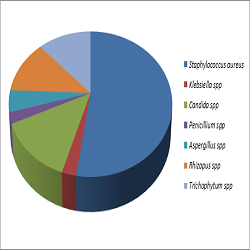Antimicrobial Effects of Coconut Oil on Athletic Foot
Keywords:
Antimicrobial, Coconut, Oil, Foot, AthleticAbstract
Coconut oil, and many other portions of the plant Cocos nucifera L, have been hypothesized to have antimicrobial and antifungal activity. Medium-chain fatty acid constituents of coconut oil including lauric acid, capric acid, and others provide antimicrobial effect. This study evaluates the effect of coconut oil on athletes’ foot and describes the proposed use of coconut products for athletes foot. Samples were collected from students of who are always putting on covered shoes using sterile cotton swabs, swabbed over the foot between the toes, and were immediately transferred for analysis. The bacteria isolates were Staphylococcus aureus and Klebsiella spp while the fungal isolates were Rhizopus spp, Candida spp, Penicillium spp, Trichophytum spp and Aspergillus spp. Out the 100-subject sampled, 46 of them were within the age range of 19 – 21 years which where the highest group in the study, while those within the age range of 16 – 18 years and 22 – 25 years where 27 in each group. From the study, the coconut oil extract had effects on the fungus with Aspergillus spp having zone of inhibition (ZI) of 21mm which was the highest ZI in the group of fungi isolated followed by Penicillium spp (18mm), Candida spp (16.8mm), Trichophytum spp (15.1mm) and Rhizopus spp (11mm) which was the least inhibited. In conclusion, the results obtained in this study have elucidated the use of coconut oil in complementary and alternative medicine, especially in this era of emerging drug-resistant Candida species and other forms of microorganisms.
Downloads
References
Aragão, W.M. (2002). Côco: pós-colheita. Série frutas do Brasil. Brasília: Embrapa Informac¸ão Tecnológica; 2002. http://livraria.sct.embrapa.br/liv_resumos/pdf/00070000.pdf. Retrieved 11-08-2017.
Zakaria, Z.A., Reezal, I., Mat Jais, A.M., Somchit, M.N., Sulaiman, M.R., Marmin, A.H.I., Sidek, H., Husin, S.H., Rahim, M.H.A. and Abdul Rahman, L. (2006). The anti-inflammatory, anti-pyretic and wound healing activities of Cocos nucifera L. (MATAG types) fresh juice and kernel extract in experimental animals, Toxicol., 1: 516–526.
Rajeev, K., Singla, N.J., Varadaraj, B. and Hitesh, J. (2011). Antioxidant and Antimicrobial Activities of Cocos Nucifera Linn. (Arecaceae) Endocarp Extracts, Indoglobal Journal of Pharmaceutical Science 3:61-72.
Passos, E.E.M. (1998). Morfologia do coqueiro. A cultura do coqueiro no Brasil. 2nd edn. Brasília: Embrapa – Servic¸o de Produc¸ão de Informac¸ão; Pp 91-98.
Andrade, A.M., Passos, P.R.A., Marques, L.G.C., Oliveira, L.B., Vidaurre, G.B. and Roch, J.D.S. (2004). Pirólise de resíduos do coco-da-baía (Cocos nucifera Linn) e análise do carvão vegetal. Rev Árvore. 28: 707–714.
Peat, R. (2005): Coconut oil: You want a food loaded with real health benefits? You want coconut oil. Available:. Retrieved 14-02-2017.
DebMandal, M. and Mandal, S. (2011). Coconut (cocos nucifera l.: arecaceae): in health promotion and disease prevention. Asian Pac J Trop Med. 4(3):241-247.
Parfene, G., Hornicar, V., Tyagi, A.K., Malik, A. and Bahrim, G. (2013). Production of medium chain saturated fatty acids with enhanced antimicrobial activity from crude coconut fat by solid state cultivation of yarrowia lipolytica. Food Chem. 136(3-4):1345-1349.
Fife, B. (2005): Eat fat, look thin: A safe and natural way to lose weight permanently. 2nd ed., Piccadilly Books, Colorado Springs, CO, USA. Pp. 22-28.
Weinberg, S.L. (2004): The diet-heart hypothesis: A critique. J. Amer. Coll. Cardiol. 43: 731-733.
Dayrit, C.S. (2000): Coconut oil in health and disease: Its and Monolaurin’s potential as cure for HIV/AIDS. Paper presented at the XXXVIII Cocotech Meeting, Chennai, India, 25 July 2000. Retrieved 14-02-2017.
World Gazzetter (2007). Population of Cities, news, divisions. http://world gazzetter.com/ng.php. Retrieved on 23/05/2017.
Thaweboon, S., Nakaparksin, J. and Thaweboon, B. (2011). “Effect of oil pulling on oral microorganisms in biofilmmodels,” Asia Journal of Public Health, 2(2): 62–66.
Pehowich, D.J., Gomes, A.V. and Barnes, J.A. (2000): “Fatty acid composition and possible health effects of coconut constituents,” West Indian Medical Journal, 49(2): 128–133.
Verallo-Rowell, V.M., Dillague, K.M. and Syah-Tjundawan, B.S. (2008): “Novel antibacterial and emollient effects of coconut and virgin olive oils in adult atopic dermatitis,” Dermatitis, 19(6): 308–315.
Bergsson, G., Arnfinnsson, J., Steingrimsson, O. and Thormar, H. (2001). In vitro killing of Candida albicans by fatty acids and monoglycerols. Antimicrob Agents Chemother. 45:3209–3212.
Ogbolu, D.O., Oni, A.A., Daini, O.A. and Oloko, A.P. (2007): “In vitro antimicrobial properties of coconut oil on Candida species in Ibadan, Nigeria,” Journal of Medicinal Food, 10(2): 384–387.
Peedikayil, F.C., Sreenivasan, P. and Narayanan, A. (2015): “Effect of coconut oil in plaque related gingivitis—a preliminary report,” Nigerian Medical Journal, 56(2): 141–147.
Hiroshige, M., Yasu, S. and Teruhiko, T. (2000): In vitro antifungal activity of FK 463, a new water-soluble edinocandin-like lipopeptide. J Antimicrob Chemother. 46:485–487.
Hughes, C.E. and Beggs, W.H. (1987): Action of fluconazole (UK-49) in relation to other systemic antifungal azoles. J Antimicrob Chemother. 19:171–174.
Thormar, H., Bergsson, G., Gunnarsson, E., Georgsson, G., Witvrouw, M., Steingrimsson, O., DeClercq, E. and Kristmundsdottir, T. (1999): Hydrogels containing monocaprin have potent microbicidal activities against sexually transmitted viruses and bacteria in vitro. Sex Transm Infect. 75:181–185.

Downloads
Published
How to Cite
Issue
Section
License
Copyright (c) 2024 Iyevhobu Kenneth Oshiokhayamhe

This work is licensed under a Creative Commons Attribution 4.0 International License.
Current Clinical and Medical Education













